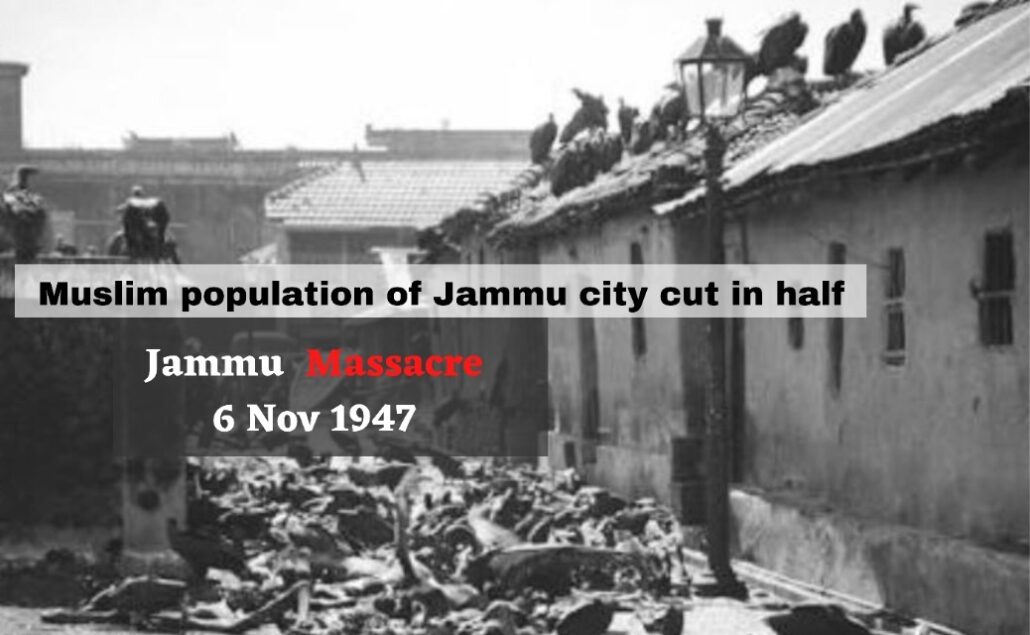
In the aftermath of partition, the risk to Muslims increased ‘every hour,’ as hordes of non-muslim migrants began flooding into Jammu from areas that would become Pakistan.
Following the March 1947 rioting in Punjab Rawalpindi, Attock, Murree, Bannu, and Hazara, the first trickle of refugees arrived in Jammu in April. The daily flood peaked in late 1947, when an estimated 160,000 Hindus and Sikhs came from Pakistan’s western provinces. (January 26, 1947, The Times, London)
During the partition-related unrest, the majority of Sialkot’s non-Muslim population had fled to Jammu. Sialkot and Jammu were essentially twin cities. The Dogras were the primary people of Sialkot’s north-eastern region. They were culturally and linguistically tied to the Hindu Dogras of Gurdaspur on one side and Jammu on the other. As the Punjab border award was announced and the unrest escalated, over 100,000 Sialkot residents fled to Jammu. (Islamabad’s Ministry of Refugees and Rehabilitation).
By mid-September, they reached 65,000 in Jammu alone. When they arrived, the communal strain reached “the breaking point.” They brought horrifying stories of “Muslim atrocities” with them, which were recounted in the press and given official credence by the state media. For example, a Jammu-based Hindu paper claimed that “a Dogra can murder at least two hundred Muslims,” demonstrating the communal depths to which the media and political parties had descended. (J. K. Rady, ‘Massacres of Muslims in Jammu Province,’ Nawa-i-Waqt (Lahore), October 29, 1947.)
This exacerbated the Muslim massacres and migration. Almost immediately, angry Dogra refugees, aided by relatives from Jammu, began a general purge of the Muslim community. State officials provided them with weapons and ammo. Non-Muslim deserters from the Sialkot Unit who had moved to Jammu and had brought guns and ammo with them now used them. (Punjab Police Abstract of Intelligence, week ending August 31, 1947, p. 612)
To make an explicit assessment of Jammu’s Muslim massacre by the State-sponsored attempt to shift demographics in 1947, it is required to examine the region’s population composition at the time. According to the 1941 Census, the eastern half of Jammu province was inhabited by 619,000 non-Muslims, including 10,000 Sikhs and 305,000 martial Dogras Rajputs and Brahmins, and 411,000 Muslims. To the north and astride the Chenab, Muslims made up 40% of the population and were in the majority in Riasi, Ramban, and Kishtwar, and had nearly reached parity in Bhadrawah. The situation of the majority of Muslims and Hindus inside the province explains in part their divergent goals for the state’s future. At the same time, it featured aspects of Leo Kuper’s posited fragmented and insecure society, which were liable to explode into ‘genocidal violence’ during a crisis, 137 Hutchison and D. Smith, ‘Genocide in the Plural Society,’ L. Leo.
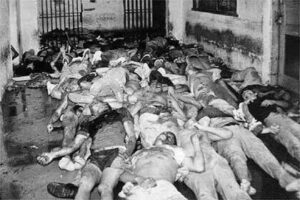
It is vital to note that the majority of Jammu province’s Muslim population was Punjabi-speaking.
The Muslims of western Jammu have long-standing topographical, historic, economic, ethnic, and cultural relations with the cities and towns of West Punjab. They were adamant about joining Pakistan. Unlike the Kashmiri-speaking Muslims of the Valley, the Valley’s Muslims embraced Sheikh Abdullah’s secular government. The placement of the majority of Muslims and Hindus inside Jammu province helps to explain their disparate goals for Jammu Kashmir.
Dogra Hindus were a minority in Jammu province overall, but they were a majority in its eastern districts such as Udhampur, Kathua, and the Chenani Jagir. Seventy-five percent of the Hindus in Jammu lived in these four districts, which were adjacent to Hindu-majority areas in Punjab, such as Gurdaspur, which was annexed into India in 1947. The bulk of Muslims in Jammu province lived in the western districts of Mirpur, Reasi, and Poonch Jagir, which were next to Punjab towns and cities. Their proximity to Punjab was essential because it let refugees travel easily into and out of Jammu province during partition.
In some locations, communal separation was much stronger. The RSS and Chaudhry Ghulam Abbas’ Jammu Muslim Conference had popular support here. Almost all communal violence occurred in Jammu province.
Thousands were slain and hundreds of thousands fled to the border cities of Sialkot, Gujrat, and Jhelum. The extent of the devastation was highest in Jammu, where Muslims were in the minority. They focused on Ustad da Mohalla, Pthanan da Mohalla, and Khalka Mohalla. The last was significantly greater than the first two combined. By mid-September 1947, these Muslim communities were a sight of devastation. Hundreds of Gujars were killed in Ram Nagar mohalla. The village of Raipur, located within the Jammu cantonment region, was destroyed by fire. The massacres and expulsion of Muslims from Jammu city exemplified the ethnic cleansing of a community.
According to the Pakistan Times (Lahore), the Muslim population of Jammu city had been cut in half by mid-September.
Hundreds of thousands of Kashmiri refugees have gathered in the border cities of Sialkot, Gujrat, and Jhelum by late November. Dogra state troops were at the forefront of Muslim attacks. The state authorities were also said to be arming not only local volunteer organisations like the RSS, but also those in neighbouring East Punjab areas like Gurdaspur.
In a statement published in the daily Nawa-i-Waqt, G. K. Reddy, an editor of the Kashmir Times, said, ‘I observed the armed mob slaughtering the Muslims savagely with the complicity of Dogra troops.’ State authorities were openly distributing guns to the mob.’ 30 Not only had the state administration demobilized a huge number of Muslim troops serving in the state army but Muslim police officers whose loyalty had been questioned had also been sent home. In Jammu, the Muslim garrison was disarmed, and the Brigadier Khoda Box of the Jammu cantonment was replaced with a Hindu Dogra commander. According to reports, the Maharaja of Patiala was not only supplying weaponry but also operating a Sikh Brigade of Patiala State troops in Jammu Kashmir.
The state government sought to create a Hindu majority in Jammu. On November 28, Dogra troops evicted the entire Muslim inhabitants of Dulat Chak, alleging it was a part of the state. The Dogra army assaulted the adjacent villages, forcing the Muslims to flee beyond the old Ujh river bed. (FIR no. 179, Sialkot District Police Record, Thana Shakargarh, 28 November 1947).
The daily Times of London highlighted the events in Jammu with such front page headlines as ‘Elimination of Muslims from Jammu’ and pointed out that Maharaja Hari Singh was ‘in person leading all the forces’ which were ethnically cleansing the Muslims.
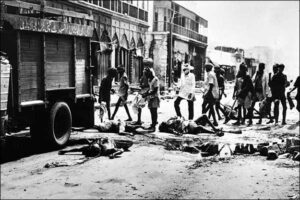
Stories of pain and loss
The Pakistani government dispatched numerous buses to Jammu in the first week of November to bring refugees to Sialkot. When the caravan arrived on the Jammu-Sialkot road, Dogra troopers, RSS men, and many more were waiting for it.
Non-Muslims ambushed the caravan, killing most of the passengers and kidnapping their wives. Those who were fortunate enough to escape made it to Sialkot.
A well-educated Muslim refugee who fled from Jammu to Sialkot is quoted in The Journey to Pakistan: Documentation on Refugees of 1947 “Dogra troops attacked thirty vehicles transporting Muslim evacuees from Kashmir State at Satwari in Jammu. The majority of the male members were massacred, while the ladies were kidnapped. He concluded that the official proclaimed there that ‘there was no place for Muslims in Kashmir State and that they should all clear out.”
Oral sources gathered in Sialkot paint a vivid picture of Jammu’s Muslims being ethnically cleansed. Zafar Butt, who arrived in Sialkot from Jammu in late 1947, claimed that the Dogra troopers massacred his entire family in Nawa Kot.
Khalid Ali Gujar’s two brothers and sister were slain in Jammu’s Ram Pura mohalla.
Khawaja Tahir, who lived in the Askari colony in Sialkot, lost his parents and brother in Jammu.
Hameed Ullah, a major Muslim Conference politician, had his small daughter taken in Jammu.
Sarmad Mahmud, who later resided in Askari colony, recounts his family fleeing turmoil in Nawa Kot and arriving in Sialkot, where they spent many years in the camp.
Similarly, Zarar Hussian, now a central government employee came from Jammu city in late 1947 and recalls the horrors in Jammu at the time. “The state troops of Maharaja were at the forefront of killings ruthlessly the Muslims in Jammu city. My father was a well-known lawyer in Jammu city court. We were forced to quit Jammu for Sialkot.”
Hussein Gujrar, who moved from Nawakot to Sialkot in October 1947, was the subject of one of the most fascinating interviews undertaken in the Sialkot district. He was 18 at the time and is currently a Tarowali mohalla resident. He recalls the events of that time quite vividly, when his entire family was killed. “I was about 18 at the time. The Dogra troopers raided our home one night and slaughtered my parents, sister, and two younger brothers. Fortunately, I was not at home that night and thus avoided death. When I got home the next morning, I found that they had all been slaughtered, and there was blood everywhere. The Maharajah’s soldiers looted everything in the house. I walked from Nawakot to Sialkot while carrying a handbag.”
The Motive
The major goal of the Hindu Dogra Princely State was to change the demographic composition of the territory by enslaving the Muslim inhabitants. The results from India’s 1961 Census clearly show the depopulation of the Muslim population in the Jammu region. In Jammu province, for example, approximately 123 villages were ‘totally depopulated,’ while the population of Muslims in the Jammu district alone decreased by nearly 100,000. In 1941, Muslims numbered 158,630, accounting for 37% of the overall population of 428,719; in 1961, they numbered just 51,690, accounting for 10% of the total population of 516,932.
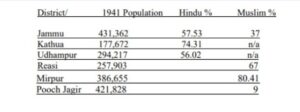
Kathua district lost over half of its Muslim population. Another well-publicized event demonstrates that there was a plan to modify the demography. Mehr Chand Mahajan, the Prime Minister of Jammu Kashmir, addressed a delegation of Hindus who greeted him when he arrived in Jammu that now that power has been given to the people, they should demand equality.
When one of them wondered how they could seek parity when the population ratios were so close. ‘The population ratio can alter,’ he said, pointing to the Ramnagar natural reserve below, where some bodies of Muslims were still lying, Anuradha Bhasin Jamwal wrote in Prejudice in Paradise
It is worth noting here that the inter-religious violence in Jammu included a suspected ‘genocide’ of Muslims in September-October 1947. The Dogra Hindu state’s Maharaja was complicit in the targeted atrocities against Kashmiri Muslims. More than ‘237,000 Muslims were ruthlessly slaughtered by all the armies of the Dogra State, led by the Maharaja in person, out of a total of 8 lakhs who attempted to migrate. (The Times (London), 10 August 1948, ‘Elimination of Muslims from Jammu,’ II.)
In the Census of 1951, Jammu province had made Hindu majority province.
More than three lakh Kashmiri refugees had gathered in the border cities of Sialkot, Gujrat, and Jhelum by late November. Because to its proximity to the Jammu region, Sialkot has received around 200,000 Jammu refugees. The city, which was accessible by road and train from Jammu, was an obvious choice for the refugees. Many Kashmiris relied on them because of pre-existing business and family relationships.
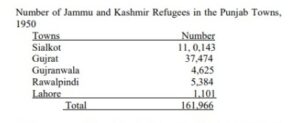
The Migration
The majority had little choice except to flee violence. Unsurprisingly, the Kashmiri refugee group became the city’s most visible community. The most fortunate occupied non-Muslims’ abandoned properties. For many years, people flocked to camps, schools, and military barracks platforms. They squatted on railway stations, sidewalks, and any other available place. In the evacuee factories, the least fortunate were housed in “the most terrible,” “de-humanized,” and “like livestock” conditions. Water and sewerage systems were typically non-existent, and unsanitary environments exacerbated health problems.
Almost all of the 20000 Kashmir refugees enrolled at Sialkot’s Ghanda Singh School contracted smallpox.
Refugees told a group of Englishmen who visited the city on November 21 terrible stories of brutal massacres by the state’s own troops and the burning of their homes and crops.
The tragic sights and anecdotes of Muslim atrocities were recounted in the press and in Friday Juma Terrible Fate: ‘Ethnic Cleansing’ of Jammu’ Muslims 131 sermons.
